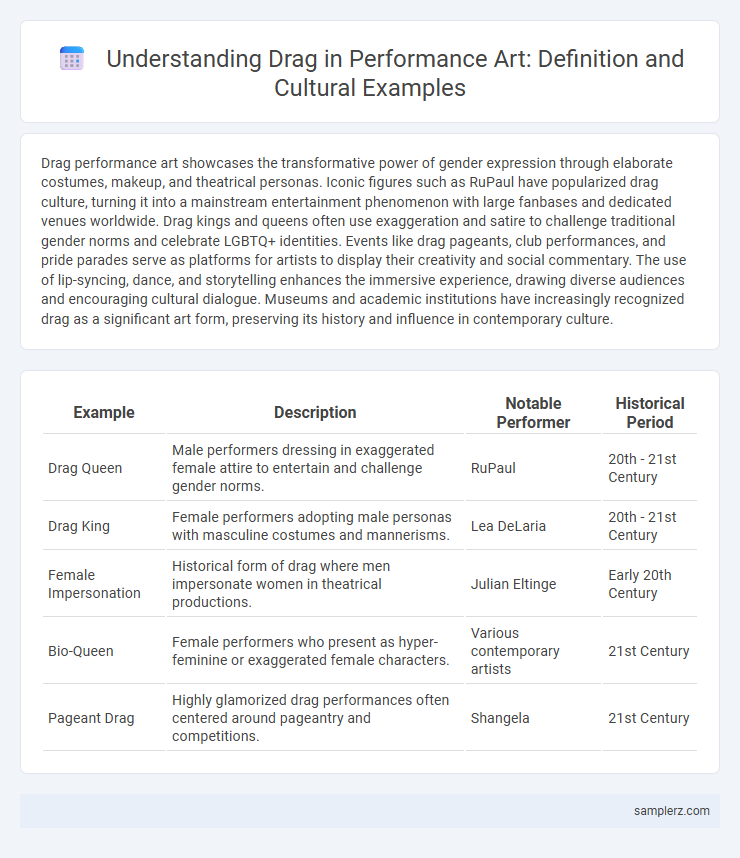Drag performance art showcases the transformative power of gender expression through elaborate costumes, makeup, and theatrical personas. Iconic figures such as RuPaul have popularized drag culture, turning it into a mainstream entertainment phenomenon with large fanbases and dedicated venues worldwide. Drag kings and queens often use exaggeration and satire to challenge traditional gender norms and celebrate LGBTQ+ identities. Events like drag pageants, club performances, and pride parades serve as platforms for artists to display their creativity and social commentary. The use of lip-syncing, dance, and storytelling enhances the immersive experience, drawing diverse audiences and encouraging cultural dialogue. Museums and academic institutions have increasingly recognized drag as a significant art form, preserving its history and influence in contemporary culture.
Table of Comparison
| Example | Description | Notable Performer | Historical Period |
|---|---|---|---|
| Drag Queen | Male performers dressing in exaggerated female attire to entertain and challenge gender norms. | RuPaul | 20th - 21st Century |
| Drag King | Female performers adopting male personas with masculine costumes and mannerisms. | Lea DeLaria | 20th - 21st Century |
| Female Impersonation | Historical form of drag where men impersonate women in theatrical productions. | Julian Eltinge | Early 20th Century |
| Bio-Queen | Female performers who present as hyper-feminine or exaggerated female characters. | Various contemporary artists | 21st Century |
| Pageant Drag | Highly glamorized drag performances often centered around pageantry and competitions. | Shangela | 21st Century |
Historical Roots of Drag in Performance Art
Drag performance art traces its roots back to ancient theatrical traditions, including the all-male casts of Shakespearean England where men portrayed female characters. In the 19th and early 20th centuries, vaudeville and minstrel shows prominently featured drag artists who challenged gender norms through exaggerated costumes and performances. These historical expressions of drag laid the foundation for modern LGBTQ+ cultural movements and the vibrant drag scenes seen worldwide today.
Iconic Drag Performers Through the Decades
Iconic drag performers such as Divine in the 1970s, RuPaul in the 1990s, and Lady Bunny have significantly shaped performance art by challenging traditional gender norms and amplifying LGBTQ+ visibility. RuPaul's groundbreaking success with "RuPaul's Drag Race" revolutionized mainstream acceptance, creating a global platform for diverse drag artists. These performers exemplify how drag combines theatricality, fashion, and social commentary to influence culture across decades.
Notable Drag Ball Events and Their Cultural Impact
Notable drag ball events such as the Legendary House of LaBeija's annual ball and the Vogue Renaissance Ball have played pivotal roles in shaping LGBTQ+ culture and performance art by providing safe spaces for expression and community building. These events showcase extravagant performances that highlight gender fluidity and creativity, influencing mainstream fashion and pop culture through iconic moves and styles like voguing. The cultural impact of drag balls extends beyond entertainment, fostering empowerment, visibility, and social activism within marginalized communities.
Drag in Mainstream Theater and Musicals
Drag in mainstream theater and musicals exemplifies the art form's dynamic versatility, showcased in productions like "Kinky Boots" and "Hedwig and the Angry Inch," where gender-bending performances challenge societal norms. These shows integrate drag as a narrative device, highlighting themes of identity, acceptance, and empowerment while captivating diverse audiences. This mainstream acceptance not only amplifies drag culture but also fosters broader LGBTQ+ representation in performing arts.
Drag as a Political and Social Statement
Drag as a political and social statement challenges traditional gender norms by using exaggerated costumes and performances to highlight issues of identity and inequality. Iconic figures like RuPaul and performances at events such as the Stonewall Riots have elevated drag as a powerful tool for LGBTQ+ activism and visibility. This art form continues to provoke conversations about freedom, acceptance, and the fluidity of gender in contemporary culture.
Drag Performance Styles: From Camp to Glamour
Drag performance styles range from exaggerated camp, characterized by humorous, over-the-top costumes and theatricality, to high glamour, featuring elegant, polished looks with intricate makeup and fashion design. Camp drag uses satire and parody to challenge societal norms, often embracing kitsch and absurdity to provoke laughter and reflection. Glamour drag highlights sophistication and artistry, blending fashion-forward aesthetics with precise performance skills to create visually stunning and culturally impactful shows.
The Art of Transformation: Makeup and Costume Techniques
Drag performance art exemplifies transformation through intricate makeup and costume techniques that redefine gender expression and identity. Artists use contouring, bold colors, and prosthetics to sculpt exaggerated features while costumes incorporate sequins, feathers, and layered fabrics to enhance visual storytelling. This blend of artistry fosters a powerful narrative of self-expression and challenges societal norms about beauty and performance.
Drag Kings vs. Drag Queens: Exploring Gender Expression
Drag Kings and Drag Queens both challenge traditional gender norms through performance art, with Drag Kings typically adopting masculine personas and styles to explore and celebrate masculinity. Drag Queens emphasize exaggerated femininity, using elaborate costumes, makeup, and theatrics to question societal expectations of gender and beauty. Both forms of drag serve as powerful platforms for self-expression, identity exploration, and cultural commentary within the LGBTQ+ community.
The Role of Drag in LGBTQ+ Visibility
Drag performance art plays a crucial role in LGBTQ+ visibility by challenging traditional gender norms and celebrating diversity through exaggerated costumes, makeup, and personas. Iconic figures like RuPaul have propelled drag into mainstream culture, fostering greater acceptance and understanding of queer identities. These performances create safe spaces for self-expression and community building, amplifying marginalized voices within the LGBTQ+ spectrum.
Contemporary Trends in Drag Performance Art
Contemporary trends in drag performance art showcase a fusion of gender fluidity, multimedia integration, and social activism, with artists like Sasha Velour and Jinkx Monsoon leading the movement. The use of digital platforms such as TikTok and Instagram has amplified drag visibility, allowing performers to experiment with virtual makeup, augmented reality, and immersive storytelling. This evolution reflects a broader cultural shift where drag transcends traditional cabaret settings to influence fashion, LGBTQ+ advocacy, and mainstream entertainment.

example of drag in performance art Infographic
 samplerz.com
samplerz.com